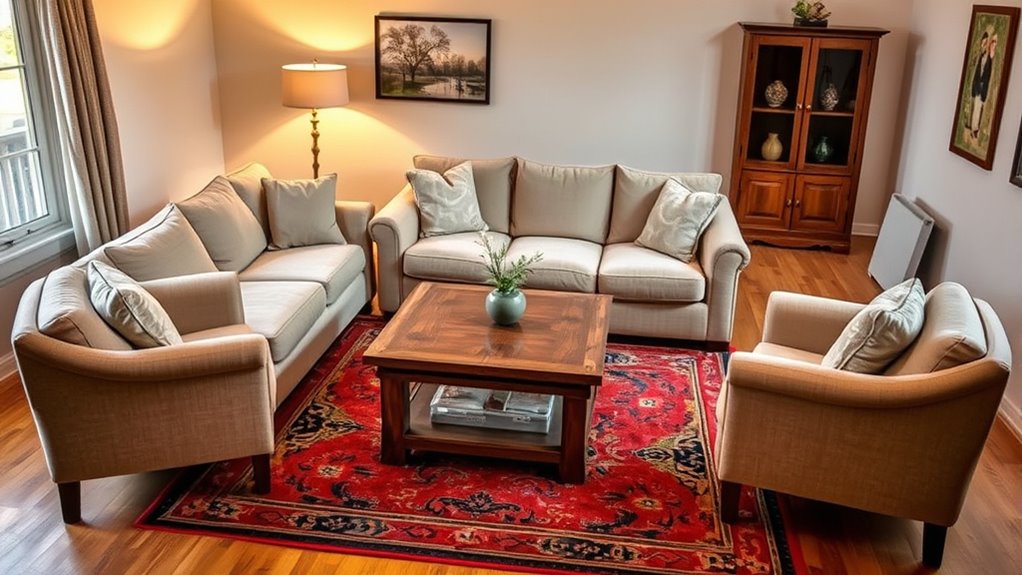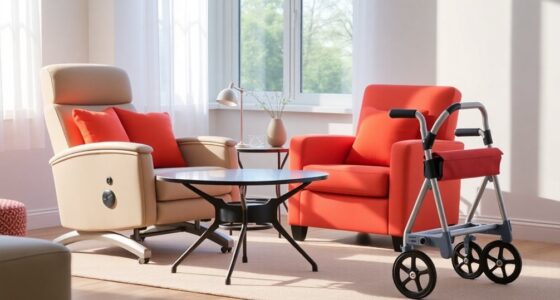To promote conversation, arrange your furniture in a way that encourages eye contact and intimacy. Place chairs and sofas in semi-circular or circular patterns around a focal point like a fireplace or coffee table. Angle chairs at about 45° for natural engagement, and create cozy clusters with 2-3 seats. Use rugs and contrasting textures to define zones and add warmth. Fine-tune spacing to keep movement smooth, ensuring your space feels inviting and easy to converse in. Keep exploring for more ideas to enhance your setup.
Key Takeaways
- Arrange seating in circular or semi-circular patterns to facilitate eye contact and inclusive conversations.
- Angle chairs at approximately 45° to promote natural engagement and reduce awkward head turns.
- Maintain 18-24 inches of clearance between furniture for easy movement and open dialogue.
- Use focal points like fireplaces or coffee tables to anchor social zones and encourage interaction.
- Incorporate varied textures and warm colors to create inviting, tactile spaces that enhance comfort and engagement.
Choosing the Right Focal Point for Your Seating Layout
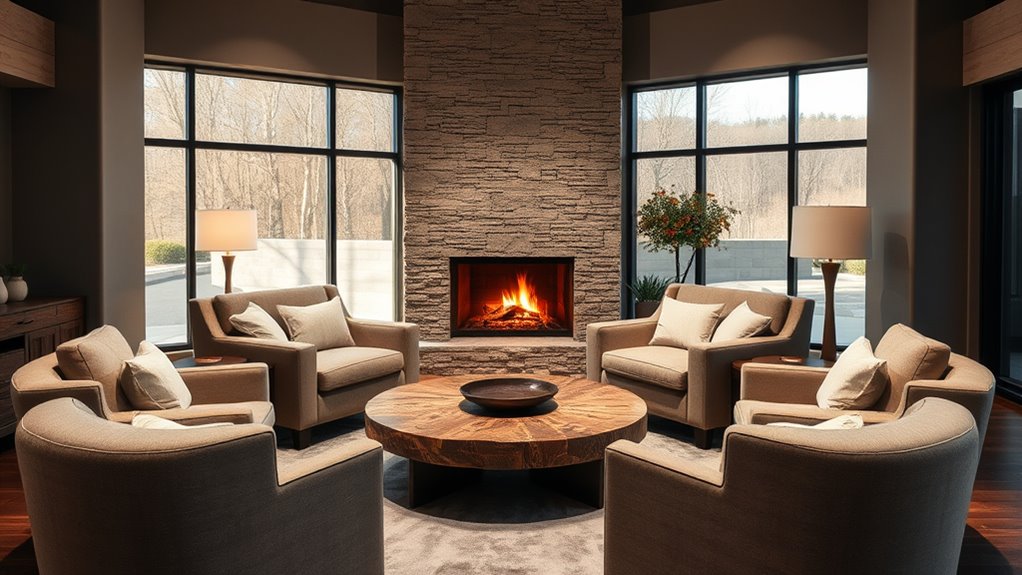
Choosing the right focal point is essential for creating a welcoming and functional seating layout. Your focal point anchors the space, guiding furniture placement and encouraging conversation. It could be a fireplace, a striking artwork, or even a large window with a beautiful view. Incorporating vintage decor into your focal point can enhance the rustic charm and make the space feel more authentic. When you position sofas and chairs to face or angle toward this focal point, it creates a cohesive, inviting environment that naturally draws people together. If your room has multiple focal points, like a fireplace and a view, you can design different social areas within the space. Make sure your focal point is both accessible and visually prominent. This helps guide furniture placement and ensures everyone can engage comfortably, typically keeping 3 to 4 feet of space for ideal conversation.
Arranging Seating in a Circular or Semi-Circular Pattern
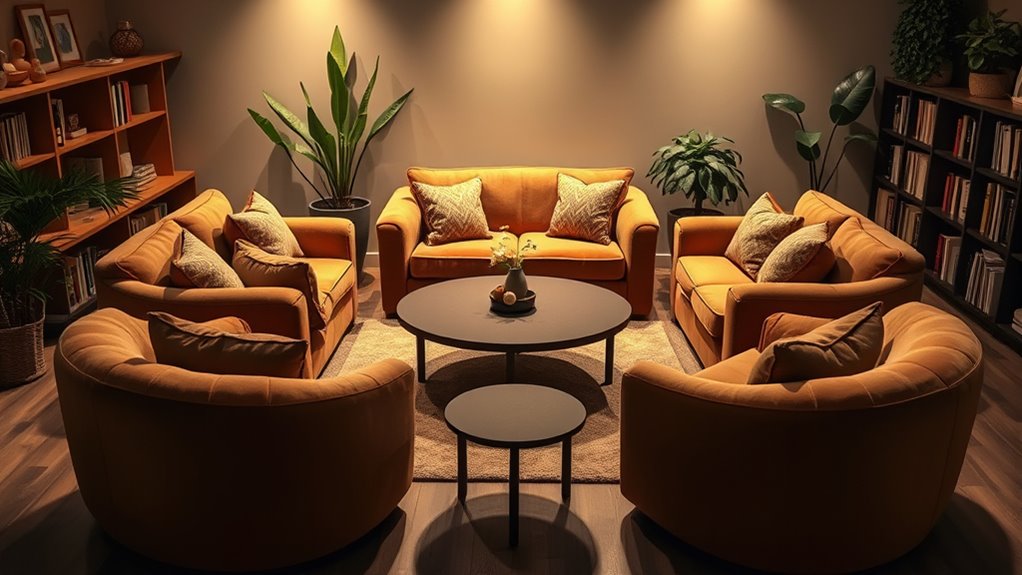
Arranging your seating in a circle or semi-circle helps everyone see each other clearly, making eye contact easier. This setup naturally encourages inclusive conversations where no one feels left out. Additionally, this arrangement can foster a sense of co-parenting harmony by promoting open communication and mutual respect among participants. Utilizing proper seating arrangements can also improve overall comfort and engagement during discussions. Proper positioning of furniture can enhance conversation flow by reducing physical barriers and creating a welcoming environment. Using specific furniture types designed for face-to-face interaction can further support meaningful dialogue. Being aware of ice cream flavors that appeal to all guests can also create a more inviting atmosphere, especially during social gatherings.
Facilitates Eye Contact
When seating is arranged in a circular or semi-circular pattern, everyone faces each other directly, making eye contact more natural and effortless. This seating arrangement removes barriers, creating an inclusive environment where visual connection is easy. Imagine:
- Chairs positioned at equal distances around a central point, promoting balance and comfortable eye contact.
- Curved sofas or rounded chairs naturally guiding guests to face each other, enhancing social flow.
- Clear sightlines that eliminate obstructions, encouraging engagement and attentiveness.
- Incorporating sound healing science principles can further foster a calming atmosphere conducive to open conversation.
- Additionally, these arrangements can facilitate water-based relaxation techniques, which promote a peaceful setting for conversation and connection.
- Proper lighting, such as soft, indirect illumination, can also enhance the overall ambiance, making the environment more inviting and conducive to dialogue.
- Using mindfulness practices can help participants stay present and engaged during conversations, deepening connections.
- Creating a relaxing environment through thoughtful design can significantly improve the quality and depth of social interactions.
Encourages Inclusive Interaction
Positioning seating in a circular or semi-circular layout naturally encourages inclusive interaction among guests. This arrangement ensures everyone faces each other, making conversations more open and engaging. It also minimizes social hierarchies by placing all seating at an equal distance, fostering a sense of equality. Incorporating essential oils for social comfort into the environment, such as lavender or peppermint, can further enhance a relaxed and welcoming atmosphere. Circular setups create a natural flow for eye contact and storytelling, which enhances group engagement. Using multiple smaller seating groups in a circle allows you to accommodate different social sizes and promotes intimacy. Incorporating rugs and central focal points within these arrangements visually unify the space, making it inviting and comfortable. Additionally, considering support hours for entertainment venues can help plan optimal times for social gatherings, ensuring better experiences. Ensuring the furniture is comfortable and supportive, such as including heated mattress pads, can also contribute to a cozy environment that encourages longer, more relaxed conversations. Creating a comfortable environment with appropriate website cookies can also enhance the overall experience and interaction comfort. Furthermore, aligning furniture arrangements with cultural beliefs surrounding astrology and beauty can subtly influence guest perceptions and interactions, adding an extra layer of harmony to your gathering. Overall, strategic seating in these patterns helps break down barriers, encouraging everyone to participate in the conversation equally.
Using Angled Chairs to Facilitate Natural Dialogue

Positioning chairs at about 45-degree angles encourages eye contact and creates a welcoming atmosphere. This setup makes conversations flow naturally. It also helps everyone feel more connected. By using angled chairs, you can maximize space and foster spontaneous, engaging dialogue. Additionally, implementing creative design concepts can further enhance the conversational environment by making the space more inviting and functional. Incorporating spatial awareness principles can optimize layout effectiveness and comfort for all participants. Embracing remote hackathons practices, such as digital collaboration tools, can also inspire innovative arrangements that adapt to diverse environments. Applying tuning techniques to furniture layout can further improve overall interaction and comfort. Exploring versatile planters can add aesthetic appeal and flexibility to your space, creating a more dynamic environment for conversation.
Optimal Chair Angles
Using chairs angled between 30 and 60 degrees toward the central conversation area encourages natural eye contact and relaxed interaction. This ideal chair angle in your furniture arrangement helps guests feel comfortable and engaged. Incorporating symbol recognition into your setup can further enhance understanding of nonverbal cues, making conversations more meaningful. When chairs are positioned at about 45 degrees, it creates a conversational triangle that fosters intimacy and ease of communication. Properly angled seating also minimizes the need for excessive head-turning, reducing discomfort. Additionally, understanding spatial awareness can help you optimize the layout for better engagement. Creating a balanced visual harmony within your space ensures that furniture arrangements promote openness and ease of interaction. Considering environmental impact when arranging furniture can also contribute to creating a more sustainable and eco-friendly space. Imagine your space with: – Chairs arranged at a diagonal, forming inviting clusters – An open layout that still defines social zones – A natural flow that encourages dialogue without feeling forced These angles help you craft an environment where conversations flow smoothly, making your room more inviting and conducive to meaningful interaction.
Enhancing Eye Contact
Angled chairs set at around 45 degrees toward each other naturally enhance eye contact, making conversations more engaging and comfortable. This arrangement creates an ideal line of sight, encouraging natural eye contact without awkward head turns.
When seating faces each other directly, eye contact can feel forced or inhibited, but slight angling fosters a relaxed, attentive interaction. Properly angled furniture reduces conversational barriers, helping you connect visually with ease.
Research shows that such arrangements increase both the frequency and duration of sustained eye contact in social settings. By positioning chairs at this angle, you make it easier for everyone involved to maintain eye contact, which promotes intimacy and active listening.
This simple adjustment considerably improves the quality of your conversations, making interactions more meaningful.
Creating Intimate Clusters With Two or Three Chairs

Creating intimate clusters with two or three chairs encourages cozy conversations by bringing people close together. In a living room, arranging these pieces of furniture around a central coffee table creates a natural focal point for every piece in the space. Position the chairs at a 45 to 90-degree angle to foster face-to-face or side-by-side interaction, perfect for sharing a cup of coffee or engaging in a personal chat. Incorporate side tables between chairs to hold drinks or personal items, making conversations relaxed and effortless. Visual interest and comfort are key—use varied textures and fabrics in your chairs. This setup, whether near the side of the fireplace or in the room’s focal point, sets the right tone for intimate conversations in your living rooms. Additionally, understanding interior design principles can help you create balanced and inviting arrangements that enhance social interactions.
Balancing Comfort and Accessibility in Furniture Placement
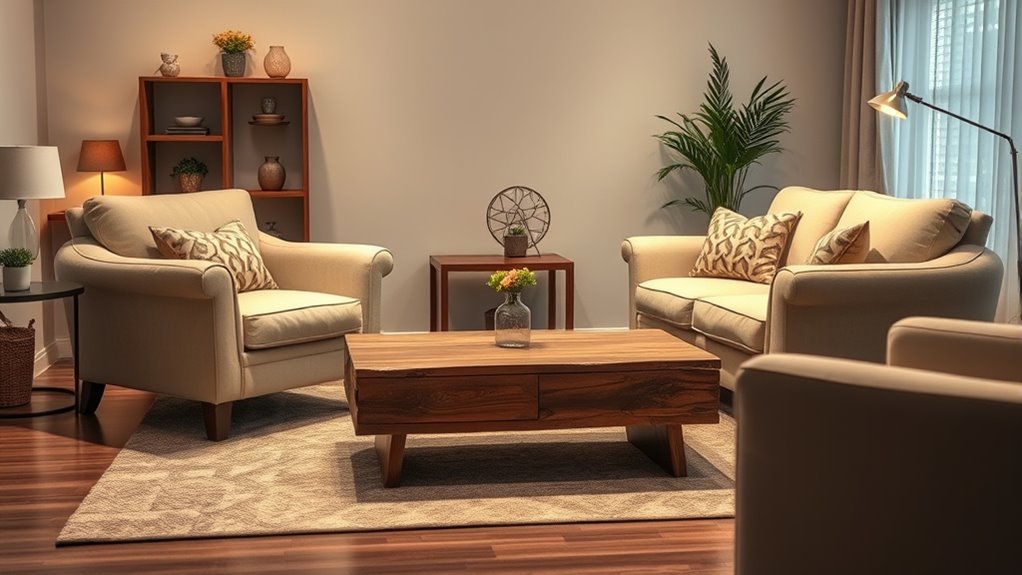
Achieving a comfortable and accessible furniture layout involves thoughtful placement that encourages easy movement and social interaction. You should leave at least 18-24 inches of clearance between pieces to ensure smooth navigation.
Position seating to face each other within a 60-90 degree angle, fostering natural eye contact and relaxed conversations. Use larger, low-profile coffee tables to provide surface space without blocking sightlines or restricting movement.
Incorporate side tables within arm’s reach of chairs and sofas for convenience without cluttering pathways. Balance plushness and firmness in cushions and upholstery to ensure comfort while offering proper support for sustained conversations.
This approach keeps your space welcoming, functional, and easy to navigate, promoting both comfort and accessibility for everyone engaging with your furniture arrangement.
Incorporating Multiple Seating Types for Flexibility
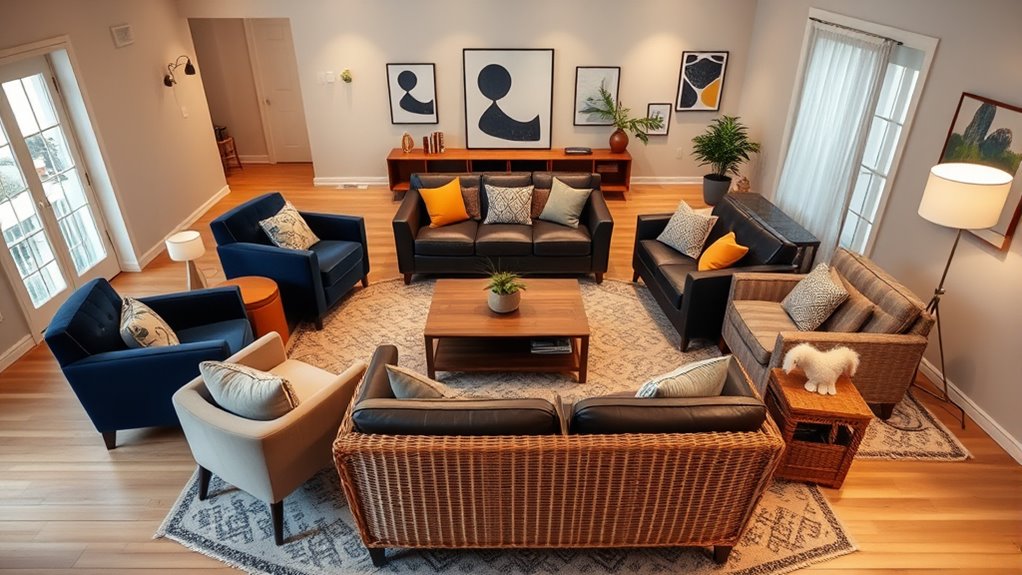
Have you considered how combining different seating types can enhance your living space’s versatility? Mixing sofas, armchairs, and ottomans creates flexible conversation zones suited for various group sizes and moods. This variety allows you to easily adjust arrangements for intimate chats or larger gatherings.
Position chairs and ottomans at angles around a central focal point to encourage eye contact and natural dialogue. Incorporating varied heights and styles adds visual interest while supporting functional clusters.
Auxiliary pieces like side tables and movable poufs boost comfort and adaptability, making your space more inviting for spontaneous interactions.
- Sofas anchor the main seating area and provide comfort
- Armchairs create cozy, intimate spots for one-on-one talks
- Ottomans serve as footrests or extra seating, easily movable
Defining Conversation Zones With Rugs and Area Fits
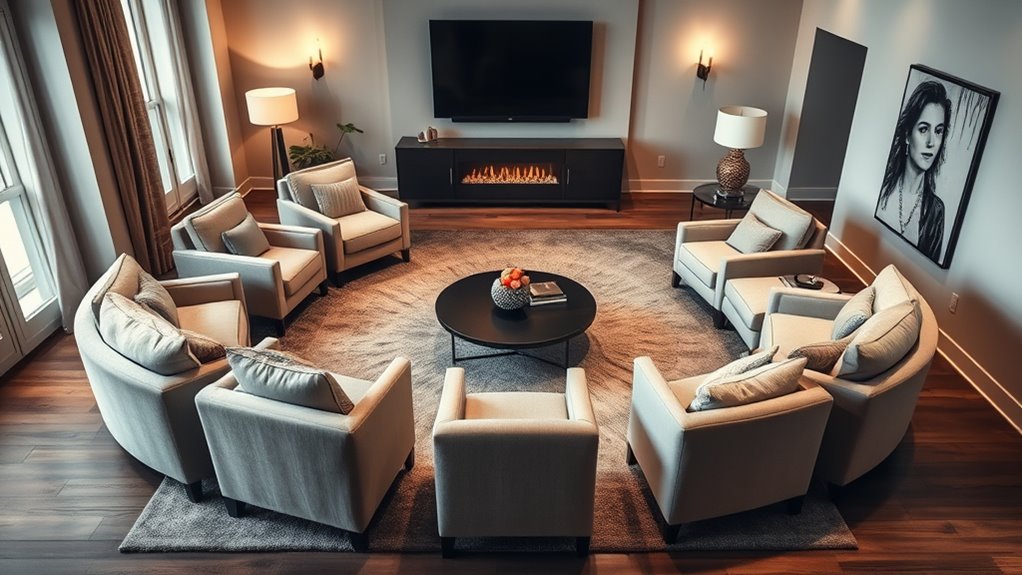
Using rugs and area fits is an effective way to define conversation zones within your living space. A large, central rug under your main seating group visually anchors chairs and sofas, creating a unified and inviting area.
Layering smaller rugs or runners around seating clusters helps subtly mark different zones in open-plan layouts. Guarantee the rug size matches your furniture, leaving at least 18-24 inches of space around the edges to allow comfortable movement.
Select rugs with patterns or textures that contrast with the floor to enhance visual separation, making your conversation areas more inviting and focused. This approach not only clarifies designated zones but also adds style and warmth to your living space, encouraging relaxed, engaging conversations.
Enhancing Engagement With Auxiliary Seating Options
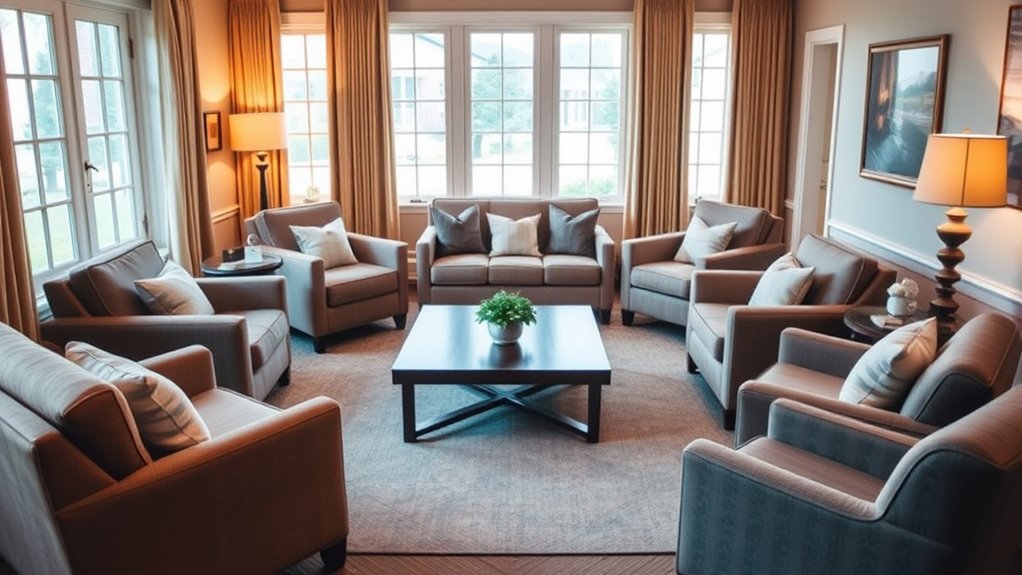
Adding auxiliary seating options like ottomans, benches, and accent chairs instantly boosts the flexibility of your living space. These pieces can be easily moved around to fit different social needs, making your room more adaptable.
Adding versatile seating options like ottomans and benches enhances your living space’s flexibility and comfort.
Ottomans serve as extra seats and encourage guests to sit closer, fostering intimacy. Benches and accent chairs fill gaps and create additional conversation zones, supporting both small chats and larger gatherings. They help maintain a welcoming atmosphere by offering accessible, comfortable seating that complements your main furniture.
To visualize this, picture:
- Ottomans that double as seats, easily moved for group conversations
- Benches providing extra seating along walls or under windows
- Accent chairs creating cozy corners for intimate chats
This versatility ensures your space remains dynamic and engaging for any occasion.
Adjusting Furniture Spacing to Promote Ease of Interaction
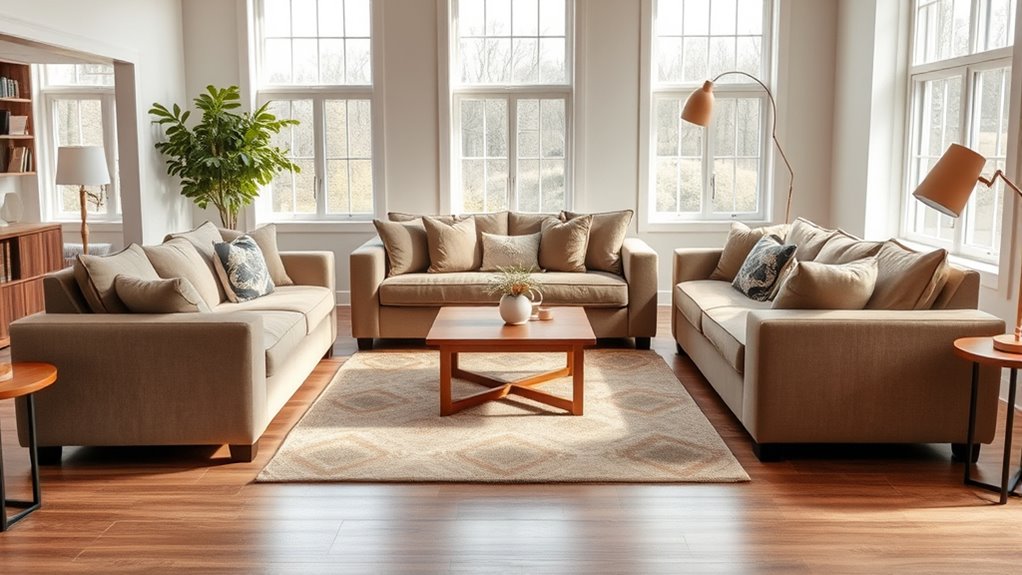
To encourage easy conversations, keep seating about 3 to 4 feet apart so no one feels cramped. Arrange chairs and sofas to face each other, creating an inviting and engaging space.
Make sure pathways are clear and wide enough for smooth movement. Use rugs or side tables to define and access conversation zones easily.
Maintain Comfortable Distances
Adjusting the distance between your furniture pieces is key to creating a welcoming, conversation-friendly space. Keeping seats about 3 to 4 feet apart fosters intimacy without feeling cramped.
Position chairs and sofas facing each other with a coffee table in between to encourage eye contact and easy interaction. For smaller rooms, place seats within 2 to 3 feet to boost closeness without blocking pathways.
Remember, room size influences spacing—more space allows for slightly wider gaps, while cozy areas benefit from closer arrangements. Use rugs or floor markings to visually define conversation zones and help maintain consistent distances.
This approach guarantees everyone feels comfortable and engaged, whether your space is large or small. Properly maintained distances make your area inviting and conducive to meaningful conversations.
Use Flexible Seating Options
Using flexible seating options like ottomans, poufs, and benches allows you to easily modify your space to suit different gatherings. You can move these lightweight pieces around to create the perfect setup for any group size or conversation style.
Adjusting the spacing between chairs and sofas helps foster an inviting flow, making conversations feel natural without feeling crowded or too distant.
Multi-purpose furniture, such as a coffee table with hidden storage or a movable side chair, makes reconfiguring your layout quick and effortless.
Incorporating lightweight pieces means you can adapt your seating arrangements for casual hangouts or more formal events.
Strategically positioning seats to form conversational triangles encourages eye contact and promotes more engaging, effortless interactions.
Optimize Pathways and Flow
Creating an inviting environment hinges on how well you space your furniture to allow smooth movement and conversation. To do this, maintain at least 24 to 36 inches of clearance between pieces.
Arrange seating in circular or semi-circular layouts to reduce twisting and reach, making conversations more natural. Position sofas and chairs around focal points like fireplaces or coffee tables to create social zones while keeping walkways open.
Spacing furniture evenly prevents congestion, so multiple groups can chat without feeling cramped. Additionally, place side tables and accent pieces along pathways to avoid obstructing flow and provide easy access to surfaces.
Utilizing Color and Textures to Invite Communication
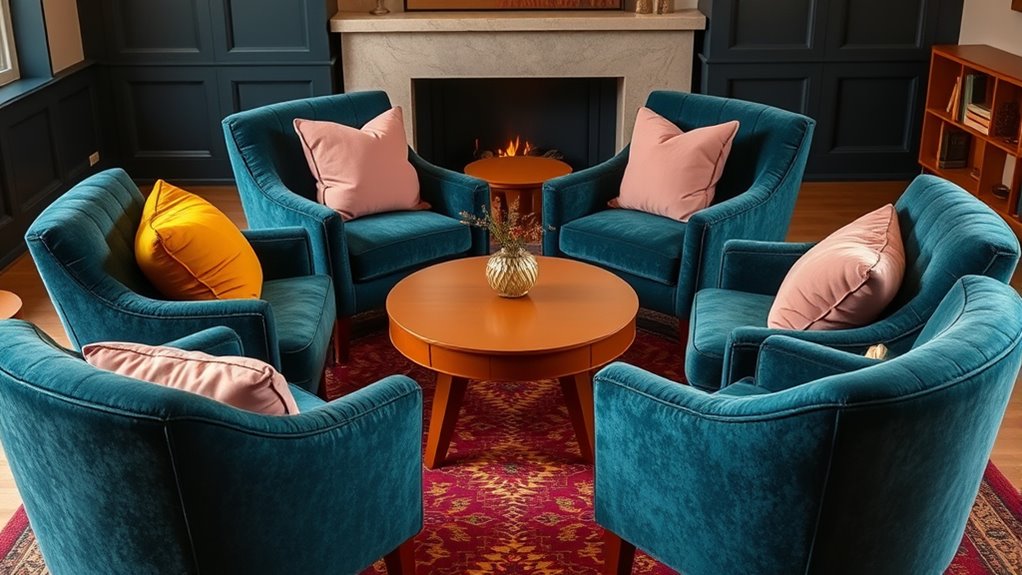
Incorporating a variety of textures and warm colors in your furniture and decor naturally invites conversation by creating an inviting and engaging atmosphere. Mix textured fabrics like velvets, knits, and woven materials to add tactile interest that encourages guests to touch and interact.
Use warm, inviting color palettes such as jewel tones or earthy hues to foster a cozy environment where conversations flow easily. Layer textiles with patterned pillows, throws, and rugs to introduce visual complexity that draws eye contact and engagement.
Choosing contrasting yet complementary colors for furniture and decor helps define distinct conversation zones, making social spaces more welcoming. Small touches like textured lamps or decorative vases subtly guide the eye, promoting interaction and making your space feel vibrant and inviting.
Frequently Asked Questions
What Is the Best Seating Arrangement for a Conversation?
To create the best seating arrangement for conversation, place your chairs and sofas in a circle or semi-circle, facing each other.
Keep them about 3 to 4 feet apart, so everyone feels comfortable and engaged.
Add a central coffee table to encourage closeness.
Mix different types of seating for variety, and make sure pathways are clear, so the flow remains inviting and easy for everyone to join in.
What Is the 2/3 Rule Furniture?
Imagine you’re setting the perfect cozy scene—that’s where the 2/3 rule comes in. It suggests placing your furniture within two-thirds of the room’s length or width, creating just enough space for easy chatting.
You’ll want chairs and sofas about 3 to 4 feet apart, so conversations flow naturally without feeling cramped or distant. This simple guide helps you craft a welcoming, balanced space perfect for engaging with friends.
What Are the Four Rules in Furniture Arrangement?
The four rules in furniture arrangement guide you to create a functional and inviting space. First, establish a clear focal point like a fireplace or TV.
Second, keep seating within 3 to 8 feet to encourage conversation.
Third, make certain pathways are unobstructed with at least 24-30 inches of clearance for easy movement.
Fourth, group furniture in odd numbers to balance aesthetics and promote social interaction.
How to Create a Conversation Area in a Living Room?
Imagine turning your living room into a hub of connection. You should arrange your sofas and chairs facing each other or around a focal point like a fireplace, creating a natural flow for conversation.
Keep seats 18-24 inches apart for comfort, and add small tables for sharing.
Use rugs to define each zone, making your space inviting, intimate, and perfect for meaningful interactions.
Conclusion
By thoughtfully arranging your furniture, you set the stage for lively conversations and genuine connections. Keep the focal point inviting, use angles and clusters to encourage interaction, and consider colors and textures to make the space feel welcoming. When you strike the right balance, you’ll find that your living area naturally becomes the heart of your home—where everyone feels at ease and the conversation flows as smoothly as a well-oiled machine.
